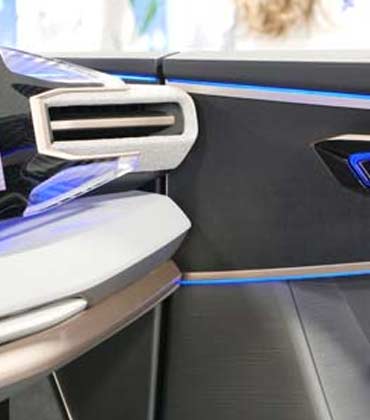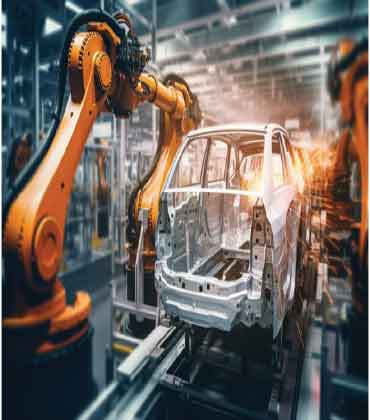THANK YOU FOR SUBSCRIBING
The future of transportation is here, and it’s autonomous. Aurora Innovation is leading the way, transforming how people and goods move. It is developing selfdriving technologies that promise to make roads safer, transportation more efficient and the world more sustainable. “We are on the brink of a new era in mobility and logistics, and the excitement from the industry, our partners and customers is palpable,” said Chris Urmson, co-founder and CEO. In a world where traffic fatalities are far too common, and transportation inefficiencies are increasing, Aurora’s technology is poised to change the transportation landscape. Its vision goes far beyond creating self-driving cars, aiming to create a fully integrated ecosystem of autonomous vehicles that can navigate the roadways, freight corridors and urban streets safely and autonomously, without human intervention. The technology promises to reduce traffic accidents, improve efficiency and lower fuel consumption and emissions, paving the way for a safer, more sustainable and accessible transportation future. Advancing Autonomous Technology Founded by Chris Urmson, Sterling Anderson and James Andrew Bagnell, three experts with years of experience in the autonomous systems industry, Aurora has established itself as a major player in the race to develop autonomous vehicles. At the heart of Aurora’s technology is the Aurora Driver, a sophisticated autonomous system that enables vehicles to perceive, reason and drive safely in various environments. Two essential components—hardware and software— power the Aurora Driver to enable full autonomy. The hardware is engineered to provide precise and reliable perception of the surrounding environment. The system integrates Aurora’s FirstLight Lidar, which allows vehicles to see far ahead with unparalleled precision, detecting objects even at high speeds and in low-light conditions. High-performance cameras and radar work in tandem to provide a complete 360-degree view of the environment, ensuring the vehicle can detect and respond to obstacles, pedestrians and other road users. The computing system processes vast amounts of data in real time, allowing for split-second decision-making that enhances safety and efficiency. Designed with fail-safe mechanisms, Aurora’s hardware ensures continued operation even in the event of individual sensor failures, making the system resilient and dependable. Complementing the advanced hardware is a software stack designed to handle the complexities of autonomous navigation. The software interprets sensor data to recognize objects, anticipate their movements and predict potential hazards on the road. Using advanced AI and machine learning, the Aurora Driver calculates the safest and most efficient driving decisions in real time, ensuring smooth and predictable maneuvers. Aurora’s high-definition maps enable precise navigation, allowing autonomous vehicles to operate accurately in complex environments. The company continuously refines its technology through extensive testing—using real-world public roads and simulated environments—to improve decision-making in rare and challenging scenarios.
The Next Phase of Autonomous Driving Imagry, an autonomous driving software provider, has created a distinctive mapless driving system that overcomes numerous challenges associated with existing technologies. Its bio-inspired technology combines real-time vision-based perception with imitation learning artificial intelligence (AI) to create a driving decision-making system. With perception and motion planning, vehicles powered by Imagry’s software understand the road in real-time and react to dynamic contexts and environments like a human driver. This approach eliminates the need for costly, geographically limiting, communication dependent and cyber-vulnerable HD maps. Over the past five years, vehicles equipped with Imagry’s technology have been driving autonomously on public roads in the U.S., Germany, Japan and Israel, demonstrating the effectiveness of its mapless approach. In line with its location-independent approach, Imagry is the first autonomous driving solution developer to demonstrate on the road both right-and left-side driving. The software processes visual input from cameras attached to the vehicle, using an array of neural networks to detect and classify objects like traffic lights, traffic signs, pedestrians, road markings, lanes, objects on the road and other vehicles. This information is processed in real-time to create a 360-degree, three-dimensional view of the immediate surroundings, allowing the vehicle to navigate dynamically and safely through any environment based on current conditions and existing road infrastructure. “We’ve spent nearly six years refining this technology, and today it is operating independently without the need for pre-mapped routes,” says Eran Ofir, CEO. Imagry caters primarily to Tier-1 suppliers, OEMs and public transportation operators. Its hardware-agnostic method lets manufacturers choose their preferred computing platforms and sensors, making it flexible and compatible across different vehicle price points. Empowering Passenger Vehicles with AI-Driven Autonomy Making significant progress in the passenger vehicle sector, Imagry is allowing OEMs to enhance their cars with autonomous driving capabilities.
Founded in 2016, ADASKY has emerged with a mission to transform vehicle safety and autonomy through innovative thermal imaging technology. The company’s success is rooted in its focus on addressing critical industry challenges and positioning itself at the forefront of these efforts. Traditional systems have long struggled with performance during nighttime, harsh winter conditions, and other low-visibility scenarios. Recognizing this gap, ADASKY set out to harness the untapped potential of thermal cameras in the automotive space. Unlike traditional optical systems, which rely on visible light and often fail in darkness or adverse weather, thermal cameras detect heat energy emitted by objects. This capability enables superior performance in environments where other sensors fall short. However, existing thermal cameras—primarily dominated by FLIR Teledyne—were costly, bulky, and reliant on outdated mechanical shutter technology. These limitations restricted their use to premium vehicle models and hindered widespread adoption. ADASKY disrupted this paradigm with its proprietary thermal imaging solution: a solid-state, shutterless thermal camera. By integrating a sophisticated microelectronic chip and patented algorithms, the company eliminated the need for a mechanical shutter, enabling uninterrupted image capture.

Qiyan Wang, VP of Engineering - Digital Systems and Yueqiang Cheng, Director, Principal Security Architect, Head of Security Research, NIO

Nick Rumberger, Executive Director, Engineering & Sales, BILSTEIN

Oliver Boinais, Sr. Manager Industrial Design at Faurecia

Reese Blalock, Director of Automotive Technical Education and Development, AAMCO Transmissions and Total Car Care

Eduardo Debone, Senior Manager, Offer Management, at Sandvik Coromant
Autonomous cars contribute to more sustainable land use and urban planning, freeing space for green areas, pedestrian zones, and community spaces.
Collaboration between automakers, technology providers, and governments fosters the development of standardized frameworks essential for scaling autonomous mobility globally.
Next-Gen Mobility with Autonomous Tech
The global evolution of autonomous vehicles is redefining transportation, driving advancements in mobility, efficiency and infrastructure development. As mobility ecosystems become increasingly interconnected, self-driving technology is emerging as a critical solution to industry challenges. With breakthroughs in AI, machine learning, 5G connectivity and autonomous ridesharing, the future of transportation is set to be smarter, safer and more efficient. Reports state that the global autonomous vehicle market, valued at $1,921.1 bn in 2023, is projected to reach $13,632.4 bn by 2030, growing at a CAGR of 32.3 percent. This rapid expansion is fueled by the integration of cutting-edge technologies that enhance vehicle intelligence, connectivity and performance. AI and machine learning enable real-time decision-making, improving safety and efficiency by allowing vehicles to learn from real-world scenarios. Mobility-as-a-Service (MaaS) platforms and autonomous ridesharing are reshaping accessibility and cost-effectiveness, offering consumers more travel options while optimizing operational costs. Meanwhile, 5G technology ensures seamless vehicle-to-vehicle (V2V) and vehicle-to-infrastructure (V2I) communication, reducing congestion and enhancing traffic flow. This edition of Auto Tech Outlook presents insights into the transformative role of autonomous vehicles in shaping the future of mobility. It features Nick Rumberger, executive director, engineering & sales at BILSTEIN, who highlights challenges in the auto tech industry like chip shortages, the shift to EV damper technologies, cost pressures and the need for faster timelines and carbon neutrality. Oliver Boinais, director, advance customer interface at Faurecia, shares insights on automated driving solutions that elevate safety, comfort and connectivity through advanced software and technology. We hope this edition, featuring the Top Autonomous Vehicle Solutions Provider of 2025, provides valuable insights to help you navigate the evolving transportation landscape and capitalize on the breakthrough technologies shaping the industry.
 Copyright © 2025 AutoTech Outlook. All Rights Reserved | Privacy Policy | Subscribe | Sitemap | About us | Feedback Policy | Editorial Policy
Copyright © 2025 AutoTech Outlook. All Rights Reserved | Privacy Policy | Subscribe | Sitemap | About us | Feedback Policy | Editorial Policy